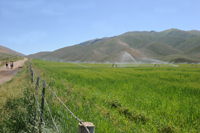The value of Blaine County’s $9 million barley crop could be cut by more than half as the result of damage caused by recent sustained rains.
Though rain is usually welcomed in a dry region such as south-central Idaho, for grain and hay farmers, it’s a disaster when too much occurs during harvest time. In Blaine County, that runs from mid-July through September.
Travis Jones, executive director of the Idaho Grain Producers Association, said that by mid-summer, south Idaho farmers were looking at a banner year. Then, two weeks of frequent rains wreaked havoc on farms across the southern part of the state nearly everywhere east of Boise. The Twin Falls area and parts of eastern Idaho were especially hard hit, but lower Wood River Valley farms suffered as well.
Most significant for barley producers is that moisture prompts the plant kernels to begin germinating, making the grain unusable for malting by beer brewers. Growers are waiting to see whether their crops will be accepted by the county’s biggest buyer—MillerCoors.
“We in Blaine County are sitting on pins and needles right now,” said Pepin Corso-Harris.
If the brewing companies reject the grain, it can still be sold for cattle feed—but at a greatly reduced price. The MillerCoors contract price is $13 per hundredweight, and according to the Idaho Barley Commission’s Idaho Grain Market report, as of Aug. 14, feed barley in this area sold for only $6. And, notes farmer John Saili, the feed market is being flooded by damaged grain, so the price could drop even further.
“The feed price is not even a break-even price,” said south county farmer Larry Schoen.
Kristy Molyneux, who with her husband, John, has a farm just north of Timmerman Hill, said this is the first time in their 30 years of farming together that their entire barley crop may have to be sold for feed.
“We won’t know until it gets tested whether it will be used for malt or for feed,” Molyneux said.
In a statement emailed to the Idaho Mountain Express, MillerCoors said, “Barley quality is of the utmost importance to MillerCoors, and we are working closely with growers to assess the damage from recent storms and ensure the quality of the barley we use in our beers. Barley growers are essential to MillerCoors’ success, and we appreciate their patience and cooperation as we work together through this challenging situation.”
“You can have a total loss of the crop, when it costs you more to put it up than you’re making.”
Scott Jackson
Jackson Trucking
Saili, who farms barley and organic alfalfa hay in Quigley Canyon east of Hailey, said he’s been taking a sample of every combine load of his barley for testing at the MillerCoors plant in Burley. He said that so far, his crop has been barely passable, but he thinks the soil in Quigley has more shale and therefore drains better than that of areas farther south in the county, where the soil has more clay.
“That’s typically a good thing, but [if it rains] during harvest, it’s not a good thing,” he said.
Picabo farmer Nick Purdy said the extent of the damage changes field by field.
Purdy said that since most Blaine County barley growers have a price set by contract with MillerCoors, a rise in prices due to the scarcity of good-quality barley won’t help them. He said some farmers have a crop in excess of the contracted amount, and they’ll be able to negotiate for a higher price on that portion.
According to the National Agricultural Statistics Service, in 2012, Blaine County farmers planted 13,100 acres in barley, 1,700 acres in spring wheat and 20,900 acres in alfalfa.
As with barley, sustained rains at this time of the year also cause germination in wheat, making it unusable for bread dough.
For hay, rain causes problems whether the plants are still in the ground or been baled. Wet hay needs to be raked out and dried, and the longer it dries, the less nutritious it becomes.
“The rain has bleached out the nutrients, microbes have eaten the nutrients and mold has started to grow,” said hay buyer Scott Jackson, owner of Jackson Trucking in Jerome. “It degrades the hay to the point that it won’t be used for milk cows for sure, and it might not be usable for feed at all. You can have a total loss of the crop, when it costs you more to put it up than you’re making.”
Jackson said this summer’s rain event is the worst he’s seen in his 30 years of handling hay.
“At this point, growers are still waiting to assess the damage,” Idaho Grain Producers Director Jones said. “But most farmers know there will definitely be damage.”
Greg Moore: gmoore@mtexpress.com
Malting barley
Malting is a process by which barley or other types of grain are made to germinate by soaking in water, and are then halted from germinating further by drying with hot air. Malting develops the enzymes required to modify the grain's starches into sugars, and creates other enzymes that break down the proteins in the grain into forms that can be used by yeast. Chris Harding, owner of River Bend Brewing Co. in Hailey, said the germination process can be induced only once, and natural germination is unlikely to have put the grain into the precise state desired by brewers. Therefore, barley that has germinated in the field is unusable for beer brewing. He said that all but the biggest brewers such as MillerCoors buy barley that has already been malted and dried.


 Quigley Canyon, east of Hailey, is one area where crops might be negatively affected by recent rains.
Express file photo
Quigley Canyon, east of Hailey, is one area where crops might be negatively affected by recent rains.
Express file photo



































